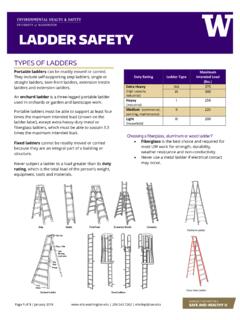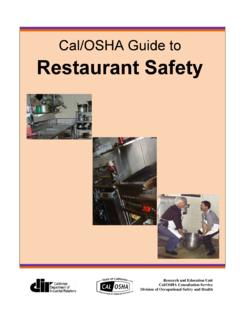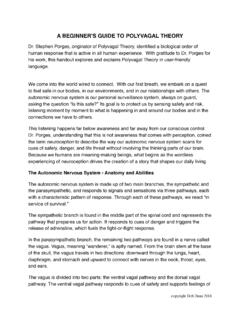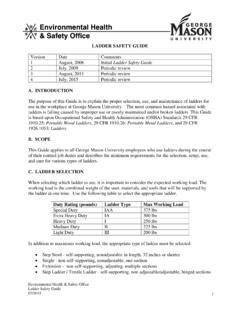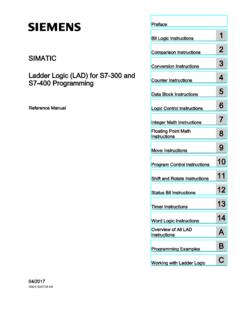Transcription of Ladder Safety Rules - OSHA. - msdssafety.com
1 Ladder Safety RulesINTRODUCTIONTo use ladders safely and effectively, craftsmen must: Know the Rules of Ladder Safety . Observe these Rules at all that practically all falls from ladders can be traced to using them in an unsafe manner. When a fall occurs, the person who falls usually gets hurt. This means that you must observe Ladder Safety Rules because you are the one who will get hurt if you don't. Others may be injured requires that safe equipment be furnished for use. But it is the responsibility of the user to USE THIS SAFE EQUIPMENT SAFELY. A fall from a Ladder can kill. It can disable a person for the rest of their life. Or it can injure him so severely that his earning power is cut off for a long time. None of these are happy prospects. They can be avoided by working safely on and around INFORMATIONL adder Safety begins with the selection of the proper Ladder for the job and includes inspection, setup, proper climbing and standing, proper use, care, and storage.
2 In addition to the general Safety Rules for all ladders there are special Rules for using stepladders and for single and extension Safety Rules are a combination of OSHA regulations and proven commonsense procedures. This combination of safe equipment and its safe use can eliminate most Ladder Safety Rules for All LaddersLadder Selection Be sure the Ladder being used has the proper duty rating to carry the combined weight of the user and the material being installed. A Ladder 's duty rating tells you its maximum weight capacity. There are four categories of duty ratings: Type IAThese ladders have a duty rating of 300 pounds. Type IA ladders are recommended for extra-heavy-duty industrial IThese ladders have a duty rating of 250 pounds. Type I ladders are manufactured for heavy-duty IIThese ladders have a duty rating of 225 pounds. Type II ladders are approved for medium-duty IIIT hese ladders have a duty rating of 200 pounds.
3 Type III ladders are rated for light-duty use. Type IA and Type I ladders are the only acceptable ladders on a construction jobsite. The American National Standards Institute (ANSI) requires that a duty rating sticker be placed on the side of every Ladder so users can determine if they have the correct type Ladder for each task/job. Be sure that metal steps and rungs are grooved or roughened to prevent slipping. Use the proper size Ladder for the job. The average craftsman will generally work most comfortably at his shoulder level, which is about 5 feet above where he stands. Since the craftsman must stand at least 2 feet down from the top of a Ladder , the maximum working height would be about 3 feet above the top of the Ladder or 5 feet minus 2 feet. For example, a 5-foot stepladder would give an effective working height of 8 feet or 5 feet plus 3 feet. When using straight or extension ladders, the craftsman stands 3 feet down from the top, which gives an effective working height of 2 feet above the Ladder top.
4 Ladder Inspection Always check a Ladder before using it. Inspect wood ladders for cracks and splits in the wood. Check all ladders to see that steps or rungs are tight and secure. Be sure that all hardware and fittings are properly and securely attached. Test movable parts to see that they operate without binding or without too much free play. Inspect metal and fiberglass ladders for bends and breaks. Never use a damaged Ladder . Tag it "Defective" and report it to the boss so that it may be removed from the Setup Place Ladder feet firmly and evenly on the ground or floor. Make sure the Ladder is sitting straight and secure before climbing it. If one foot sits in a low spot, build up the surface with firm material. Do not try to make a Ladder reach farther by setting it on boxes, barrels, bricks, blocks or other unstable bases. Do not allow ladders to lean sideways. Level them before using. Brace the foot of the Ladder with stakes or place stout boards against the feet if there is any danger of slipping.
5 2 Never set up or use a Ladder in a high wind, especially a lightweight metal or fiberglass type. Wait until the air is calm enough to insure Safety . Never set up a Ladder in front of a door unless the door is locked or a guard is posted. Do not use ladders on ice or snow unless absolutely necessary. If they must be used on ice or snow, use spike or spur-type Safety shoes on the Ladder feet and be sure they are gripping properly before climbing. Use Safety shoes on Ladder feet whenever there is any possibility of Climbing and Standing Keep the steps and rungs of ladders free of grease, oil, wet paint, mud, snow, ice, paper and other slippery materials. Also clean such debris off your shoes before climbing a Ladder . Always face a Ladder when climbing up or down. Use both hands and maintain a secure grip on the rails or rungs. Never carry heavy or bulky loads up a Ladder . Climb up yourself first, and then pull up the material with a rope.
6 Climb and stand on a Ladder with your feet in the center of the steps or rungs. Do not overreach from a Ladder , or lean too far to one side. Overreaching is probably the most common cause of falls from ladders. A good rule is to always keep your belt buckle inside the rails of a Ladder . Work as far as you can reach comfortably and safely, then move the Ladder to a new position. Never climb onto a Ladder from the side, from above the top or from one Ladder to another. Never slide down a Use of Ladders Never use metal ladders around exposed electrical wiring. Metal ladders should be marked with tags or stickers reading "CAUTION-Do Not Use Around Electrical Equipment" or similar wording. RULE of THUMB: If the overhead power line is 50 kV or less, then stay at least 10 feet away. For everything else, keep at least 35 feet away. When using a Ladder where there is traffic, erect warning signs or barricades to guide traffic away from the foot of the Ladder .
7 If this is not possible, have someone hold and guard the bottom of the Ladder . 3 Do not try to move a Ladder while you are on it by rocking, jogging or pushing it away from a supporting wall. Never use a Ladder when under the influence of alcohol, on drugs or medication, or in ill health. If you get sick, dizzy or panicky while on a Ladder , do not try to climb down in a hurry. Wait. Drape your arms around the rungs; rest your head against the Ladder until you feel better. Then climb down slowly and carefully. Do not leave tools or materials on top of ladders. If they fall on you, you can be hurt. If they fall on someone else, your company can be sued. Never push or pull anything sideways while on a Ladder . This puts a side load on the Ladder and can cause it to tip out from under you. Allow only one person at a time on a Ladder unless the Ladder is specifically designed for two people. Never use a Ladder as a horizontal platform, plank, scaffold or material hoist.
8 Be cautious about homemade ladders. Never use ladders made by fastening cleats across a single narrow rail, post or pole. Never use a Ladder on a scaffold platform. If you need to reach higher, the scaffold should be Ladder Care and Storage Maintain ladders in good condition. Keep all Ladder accessories, especially Safety shoes, in good condition. Wood ladders, which are to be used outside, should be treated to prevent weather damage. A clear finish or transparent penetrating preservative should be used. Linseed oil is a good treatment for a wood Ladder , although it does add some weight to the Ladder . An oil treatment also helps to rustproof the metal parts of a wood Ladder . Never paint a wood Ladder . This will cover dangerous cracks or fill and hide them. Never sit on Ladder side rails. Never use a metal or fiberglass Ladder which has been exposed to fire or strong chemicals, it should be discarded.
9 Never store materials on a Ladder . 4 Store wood ladders where they will not be exposed to excessive heat or dampness. Store fiberglass ladders where they will not be exposed to sunlight or other ultraviolet light sources. Be sure that ladders are properly supported and secured when in transit. Vibration and bumping against other objects can damage them. Store ladders on racks, which give them proper support when not in Safety Rules for Stepladders Never use a stepladder over 20 feet long. Always open a stepladder completely and make sure the spreader is locked open before using the Ladder . Never substitute makeshift devices of wire or rope for stepladder spreaders. Do not stand higher than the second step from the top of a stepladder. Especially, do not stand or sit on the top cap, or stand on the pail shelf, or on the back of a stepladder. Do not straddle the front and back of a Safety Rules for Single Ladders and Extension LaddersLadder Selection and Inspection Remember that the sections of an extension Ladder should overlap enough to retain the strength of the Ladder using the following table:Length of Ladder Required OverlapUp to 36 feet3 feetOver 36 to 48 feet 4 feetOver 48 to 60 feet 5 feet Of course, the usable length of the Ladder is shortened by the amount of the overlap.
10 Never splice or tie two short ladders together to make a long section. Top support for a Ladder is as important as good footing. The top should rest evenly against a flat, firm surface. If a Ladder is to be leaned against roof gutters, the strength and stability of the gutters should first be tested. 5 When a Ladder is used for access to an upper landing surface, it must extend three rungs, or at least three feet above the landing surface. A Ladder used for access to an upper landing surface should be secured against sideways movement at the top or held by another worker whenever it is being used. Extend an extension Ladder only from the ground. Determine the needed height, extend and lock the fly section securely in place then set it up against the wall. Check for stability and support before climbing. If possible, the base of a long Ladder should be secured to the ground and the top should be tied to the upper landing surface.
